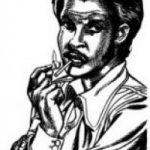Lindemann, Danielle J. 2012. Dominatrix: gender, eroticism, and control in the dungeon. Chicago ; London : The University of Chicago Press, 2012.
“Professional dominatrix” is an archetype that attracts attention out of proportion to the number of people who actually fit that description. For many, they are the symbol of BDSM in general, a representation of the perversity of men, simultaneously attractive and absurd. Are they trickster courtesans manipulating men via their weaknesses, or just another type of sex worker?

Lindemann’s book is a sociological study of professional dominatrixes, based on extensive interviews with pro dommes and their clients in New York City and San Francisco (probably the two largest concentrations of pro dommes in the USA). She spoke with both house of domination employees and independents. Her driving question is, what does professional domination, a small, highly stylized subculture, tell us about the rest of the world. She references Judith Butler’s studies of drag, an exaggeration that highlights an underlying truth. [Pg.10]
This book goes beyond some of the cliches about BDSM and pro domination, particularly the cliche that “the submissive has all the power”. Her interviews with pro dommes and client describe a delicate and nuanced struggle for control between the two parties. [Pg.33] Some pros say they are in control of the scenario, while others view it as more collaborative, even if their persona is the imperious queen. Lindemann describes several “cognitive strategies” pros use to manage this ambiguity, such as “the hustle” or the concept of “getting over” used by street vendors, the belief that despite all appearances, they are the ones who come out ahead of the transaction. [Pg.35] In the case of pros who work in houses of domination, there’s a third party with its own agenda in the equation.[Pg.38]
The “professional” part of professional dominatrix is how pro dommes construct their identity as an elite subset of sex workers, who might deny that they are sex workers at all, or at least exploit a legal loophole to work within the letter of the law. While apparent inexperience might enhance the appeal of a stripper or escort, a domme is supposed to be perfect, a mistress of her field.[Pg.72] Claims of training and experience create a mystique of authenticity. Ideally, a pro domme is supposed to do this as a calling, like an art form. To say “I’m just doing this to pay for dental school.” would spoil the experience[Pg.71, 85] One pro distinguished herself from other “hoochie dommes”: “They are contributing to the deterioration of the honor of what being a domme is.” (emphasis in original) [Pg.86] This is why, for instance, dommes who practice financial domination are viewed with suspicion and disdain by “purists”, who view findom as requiring no skill or artistry.
The other side of this equation is the client, who are trained by the BDSM culture of munches, Fetlife, online ads, etc.[Pg.60] Some clients willingly buy into the mystique of the all-powerful domme, which paradoxically desexualizes the women. By viewing these women as untouchable and asexual, the clients manage their emotional intimacy.[Pg. 113]
The space of the dungeon allows the exploration of alternate gender identities, but always in tension with the roles of the rest of the world. While pro dommes may cultivate the image of la belle dame sans merci, a taboo form of aggressive femininity, in interviews they often describe what they do as a kind of therapy, conforming to the role of woman-as-nurturer-of-men.[Pg.128, 144] This justification suggests that men’s masochistic and submissive desires are pathological, and pro dommes are doing the “work” of sustaining men in their normative sexuality and gender roles. [Pg. 147, 151] This folk belief gives the dommes a benefit too, allowing the expression of an uber-bitch role while being, underneath, a good, caring woman. They can move between different feminine archetypes. Certain subtypes of female domination strongly emphasize the quasi-maternal, nurturing roles of “mother”, “auntie”, “governess”, or “nurse”. (Lindemann suggest this is why the dynamic between dommes and their few female clients is very different; these client have no social power to reverse.[Pg.161]) BDSM may play with conventional gender roles, but it can’t completely escape them. [Pg.168]
The book ends with a woefully short, two-page historical background. Lindemann’s research says that “dominatrix”, in the BDSM sense, first appears in 1967, in The Bizarre Lovemakers, by Bruce Rogers. “Dungeon”, in the BDSM sense, goes back to 1974, in a classified ad in the Los Angeles Free Press. [Pg. 200] Though the terms “dominatrix” and “dungeon” are pretty new, there’s plenty of evidence that women provided professional domination services in the 18th and 19th centuries. Lindemann could have provided even a brief reference to Ian Gibson’s The English Vice. This is a personal quibble from a historian’s perspective on a fascinating and informative book.
The paradox of the “bitchy nurturer” put me in mind of Hannah Cullwick, and how Arthur Munby was fascinated by the strength and roughness of her body while emphasizing the sweetness and gentleness of her nature. We know that there were a lot of ageplay elements of their relationship, with him sitting on her lap or being carried. Anne McClintock’s Imperial Leather talked a lot about the “two mothers” of the Victorian bourgeois home, the “wife” and the “maid”. In our own time, there are still divides between good women and bad women, and the narrative of the “bitchy nurturer” allows us to accept this apparent paradox. The dominatrix may appear to be the polar opposite of the housewife, but they both do emotional labor for men. This rationale turns up in many narratives of fictional dommes, such as Lady Heather in CSI: Las Vegas.




[…] J Lindemann’s book Dominatrix discusses the problems of the “healing” narrative of explaining and justifying pro dommes. Not […]
[…] her book Dominatrix, Danielle J Lindemann explores the particular role of professional dominatrixes and their […]
[…] discussed in Danielle J Lindemann’s book Dominatrix, pro-dommes often normalize their role by comparing themselves to healing […]
[…] Bonding is right that empathy is required for a good dominatrix, and for the therapist Tiff says she wants to be, and it’s one of the things lacking from in her life in general. It does lean heavily on the dominatrix-as-therapist trope we’ve seen from the book Dominatrix. […]